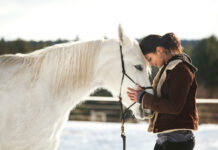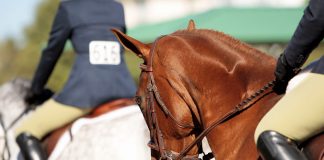
Heading into the show ring is stressful enough—the last thing you need is a wild ride in the warm-up ring beforehand. At hunter/jumper shows, the warm-up can be a crowded, chaotic place with horses and riders everywhere, going in every direction, plus trainers calling instructions and riders vying to use the same practice jumps. Being prepared with a plan in place improves your chances for a successful warm-up. Knowing the expected “rules of the road” will help you navigate your horse confidently through traffic and get the most out of your warm-up ride.
Mental Preparation
“I create a systematic approach to the warm-up that mimics what riders do at home,” says Banister. “Before they ever set foot in a ring, they have adjusted their stirrups, secured their helmet and put on their gloves; everything is in place before they mount, so that no adjusting will be necessary.”
Matt Payne, riding instructor, show team coach and admissions liaison at Sweet Briar College in Sweet Briar, Va., tries to mentally prepare his students for the chaos of the warm-up at home before they go to a show. He describes the atmosphere to them and reminds them that he will try to schedule warm-ups when the ring is not overwhelmingly busy, if possible.
Warm-up Goals
When you’ve safely arrived at the showgrounds, it’s time to take a look at the warm-up ring. Both Banister and Payne agree that this is not a place to train your horse. It’s simply there to show him his surroundings and allow you to work off some anxious energy. Both instructors go over the warm-up ring goals with their riders before allowing them to enter the arena.
“I tell my riders in what order they will school the jumps and lines,” says Payne. “They typically warm up with a single jump or a trot-in/canter-out line if one is available.” Both Payne and Banister stand in the ring with their students as they warm up, in a location where students can safely approach and stand should the instructor need to clarify a point.
Survival Strategies
There are several tried-and-true survival tactics that apply to virtually all warm-up rings, regardless of the level of the show.
Keep a safe distance between horses. Maintaining at least one horse length from other horses will ensure the safety of you and your mount if another horse kicks or becomes anxious.
Go with the flow of traffic wherever possible. Some horses can get nervous and spin or bolt when other horses travel at them head-on.
Always pass left shoulder to left shoulder, like driving a car.
Banister stresses to her students that they need to keep their head up, look where they’re going, and rely on their peripheral vision to tell them where others are in the ring.
Speed takes the rail. If you are going at a slower pace than most of the riders around you, or if you’re warming up with some lateral work, stick to the inside track.
State your intentions. Some riders can get confused if they hear “inside!” or “outside!” They’re not sure if the caller is staying to the stated direction or if they are to go there. Instead, Banister has her riders say things such as “I’m on your left” or “I’m riding on your inside”; these definitive directions are more clearly understood.

Call your fences if the warm-up is busy. If not many people are jumping, a simple “heads up” will usually suffice to let other riders know you’re planning on jumping. If there are multiple warm-up fence options, it can be in everyone’s best interest if you say the name of the fence you intend to jump. By simply stating “oxer” or “cross-rail,” you have let other riders in the ring know which fence you are planning to jump, allowing them to plan accordingly. Additionally, if you’re going to jump multiple fences in a row, be prepared to call out the next fence as soon as you land.
Don’t use the warm-up ring as a place to walk around and talk to your friends. It’s meant to get your horse used to all of the activity and to ready him for your classes. Chatting with friends or lollygagging around on the rail is impolite and unsafe.
Dealing with Rider Rudeness
Unfortunately, there will be times when you have to ride with a rider or trainer who hogs the jumps and never gives other competitors a chance to use them. It’s frustrating and can add to the sense of stress in the ring.
You can kindly ask to use a fence at the same time as another rider. If you’re told that you can use the jump when they are through, sometimes it’s best to simply use another fence or wait until the fence hog is done schooling. As annoying as it is, it’s not worth escalating an already tense situation by pointing out that they’re not being polite.
Loose Cannons
At some point, you’re going to be in the ring when a rider falls and a horse gets loose. It’s imperative that you immediately halt your horse until the escapee is caught. Payne advises his riders to dismount and hold their horses. Banister prefers her riders not to dismount if their horses are calm. Rather, she wants them to stay together, head to a corner of the arena and face their horses toward the inside of the ring. This prevents the loose horse from getting behind them and startling their mounts.
Your horse might get wound up at the sight of another horse running free with no rider, so be prepared for him to be energized when you go back to work. Payne says that if you’re not sure you can safely work him down, exiting the warm-up ring may be in your best interest.
Another situation you will probably encounter is a rider who is dangerously out of control but who still insists on trying to jump. Payne will typically suspend his student’s schooling until the other rider has finished, and suggests other riders do the same. There’s no sense in making your horse more anxious and potentially placing yourself in a dangerous situation.
“In addition to being aware of the riders around you, you can reduce the chance of warm-up-ring wrecks by avoiding the urge to circle,” says Banister. If riders are feeling anxious or don’t see a distance, she encourages them to stop or fade to the side and halt instead of riding a circle. The surprise turn could create havoc if there happens to be a horse coming up on the inside.
Payne says the warm-up ring is like driving on the road. You should stay in your lane and not bolt across traffic or slam on the gas or brakes. Also remember to change speed or direction gradually so you won’t surprise other riders in the ring and create a scene.
After the warm-up, both Payne and Banister take their students out of the ring to talk about the session. With space typically at a premium in the warm-up, it’s not only courteous to give more room to those who are still working, but it’s also safer.

Meltdown Management
Sometimes the warm-up ring is too overwhelming for green horses to be productive. If your horse becomes so much of a handful that you’re jeopardizing the safety of others, remove yourself from the situation and go to Plan B. This might include longeing in a designated area (not the warm-up) or asking your trainer for help. If all else fails and you can’t seem to calm your horse down, scratching from your classes and simply letting him hang out at the show may end up being your best option.
Some horses might never be able to handle the pressure of a warm-up, no matter how many times they have shown; forcing them into the ring will simply make them anxious and unhappy. Typically, these horses have had a bad experience in a warm-up ring before, such as a crash, and they are now consistently afraid when in similar situations. In such cases it’s best to take advantage of the judged warm-up classes as your show prep instead of stressing your horse out in a crowded ring. These classes are held before the division starts and typically count for points.
Minding your manners and being aware of other riders go a long way toward making the warm-up ring safe for everyone. Keeping these tips in mind will allow you to have a safe, productive warm-up ride and set the stage for a stellar round.
Liked this article? Here’s more advice for horse-show success:
Be a Horse Show Buddy
Show Where You’ll Shine
5 Ways to Keep the Fun in Showing
This article originally appeared in the June 2014 issue of Horse Illustrated. Click here to subscribe.






good advice
cool
Great advice.